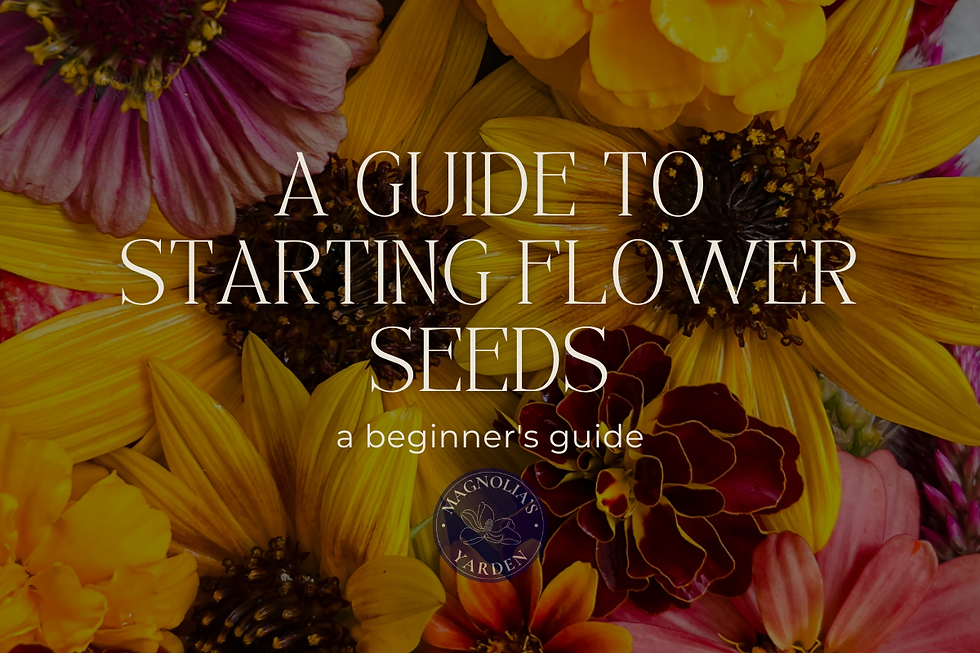The Fresno Garden: Top 10 Vegetables to Grow in Your Winter Garden
- Magnolia's Yarden
- Aug 18, 2020
- 5 min read
Updated: Jul 27, 2025
Yes, you can grow a thriving vegetable garden in Fresno during winter—right here in the Central Valley. Let’s dig in.
Living in California’s Central Valley—where agriculture is the heartbeat of our region—means that even when most parts of the country are bundling up and buttoning down, we’re still growing. Thanks to our Mediterranean climate and mild winters, Fresno and Clovis gardeners can enjoy a productive and flavorful winter vegetable garden right in their backyard.
That’s right—a winter garden. You can grow leafy greens, root vegetables, and nourishing herbs that carry your kitchen through the cooler months. In this post, we’ll walk you through what to plant, when to plant it, and how to give your garden a strong seasonal start. And soon, we’ll share comforting seasonal recipes to help you bring those homegrown ingredients straight to the table.
A Few Garden Coach Tips Before You Plant
If you’re growing from seed, August is the time to start. Yes, we know—triple-digit heat doesn’t scream “winter veggies,” but this is when seeds need to begin. Use a seed-starting tray with a clear lid to retain moisture and create a greenhouse-like environment. The key here is to keep those seeds from drying out in the late-summer heat.
Prefer Plant Starts?
September is a lovely time to transplant starter plants from your local nursery—those handy 6-packs or 4-inch containers you’ll find at your favorite garden center. The soil is still warm, which helps young roots establish and encourages stronger, deeper growth before the true chill of winter sets in.
Whether you’re starting from scratch or picking up plants ready to go, fall is the moment to invest in your edible garden and enjoy fresh, homegrown groceries all winter long.
Our Top 10 Vegetables to Grow in a Fresno Winter Garden
Now for the fun part—what to plant! Here are 10 of our favorite cool-season crops that thrive in the Central Valley and keep your kitchen stocked with garden-grown goodness.
1. Leeks

Leeks are a chef's friend in the kitchen, and soon they will be your friend, too!
Leeks are related to garlic, onions, and chives, and their mild onion flavor lends itself to creative stir-fry, soups, or stews. Eat cooked.
Plant seedlings in mid-September. Mature at 60-90 days. One crop per season.
2. Broccoli

Broccoli is a cool-season annual in the same family as kale, cabbage, bok choy, and Brussels sprouts.
Broccoli plants look like trees with firm, tight crowns. The unopened flower is the edible part! By cutting the main flower head, several smaller flowers, known as side shoots, will begin to grow. This allows you to harvest more broccoli.
Grow as seedlings in mid-September or start seeds as early as August. Harvest about 50-80 days later to enjoy steamed or in your favorite broccoli cheddar soup. One crop per season.
3. Carrots

Everybunny loves colorful, crunchy carrots! From your basic orange to white to black, there is a carrot at the end of your root-crop rainbow.
Carrots are great raw, steamed, or oven-roasted with a buttery glaze.
Carrot seeds may be planted in August, in succession, for an autumn harvest and again in April for a summer harvest.
4. Peas

Peas are a cool-season crop, and hot summer days are perfect for planting peas.
Look for sweet vining or bush varieties for picking and harvesting fun with the kids. Plant in August for an October crop of peas and plant again in mid-April after the danger of frost.
Sixty days to harvest. Steam your peas, add a smidgen of butter, and you're good to go!
5. Swiss Chard

Versatility and Swiss chard go hand in hand.
Green or multicolored stalks will enhance your yard as well as the palette of your veggie garden. Start your seeds in August or plant your seedlings mid-September.
Repeat in spring after frost. Harvest in 60 days. Use your chard in salads, stir-fries, or soups.
6. Lettuce

Lettuce is the American standard for salad making.
Choose red-leaf lettuce for color and Romaine for bulk and texture. To reduce the risk of bolting due to summer heat, plant your lettuce seeds in early September.
Seedlings may be planted in late September or early October.
7. Artichokes

Artichokes are a delicious perennial! They produce several crops a year once established and grow to 3' X 3'.
Steam or boil to cook this delicacy. Peel back the layers and enjoy dipping them in mayo or olive oil. The fuzzy heart is worth the effort of getting to the meat of the artichoke.
If allowed to flower, artichokes make an interesting purple flower bouquet that will last for years. Hang upside down to dry.
Plant as seedlings or from a container in late spring or late summer.
8. Spinach

Eat your spinach for vitality! Naturally high in iron, steam it or try it raw in salads.
Plant this simple vegetable by seed in mid-August or seedlings in mid-September. Early spring crops are possible in April.
Dress with a dab of butter, salt, and pepper, just like PopEye did!
9. Onion

Throw an onion into the mix when cooking meats and vegetables. Related to garlic, chive, leek, and shallot, the onion is the top veggie in the kitchen of culinary aspirations. When do you NOT use an onion?
Plant seeds in mid-August and seedlings in mid-September. Plant again with onion starts in spring after the last danger of frost.
10. Kale

Big and leafy is what kale is all about! With varieties like "Dinosaur," kids dig this plant.
Easy to grow, fun to eat, and pretty in the garden, kale is packed with nutrition and taste. Eat green or baste with olive oil and a sprinkle of sea salt, and bake.
Plant seeds in mid-August and seedlings in mid-September. Repeat in the spring after the danger of frost has passed.
This gentle seasonal rhythm—sowing in summer’s final heat, harvesting in winter’s calm—is what makes vegetable gardening in California so special. It’s a quiet kind of abundance, and we’re here to help you grow it.
Thank you for exploring our 10 favorite veggies to grow this winter! At Magnolia’s Yarden, we’re here to help you grow with confidence—whether you’re starting fresh or tending to a seasoned space. If you’re unsure where to begin, we’d love to dream it up with you. Let’s chat about how your garden can nourish your table and your joy.
🌱 Request a Garden Consultation and let’s grow something beautiful together.
Happy gardening!
~ Danielle
❀ Live your best botanical life from the garden to the kitchen! ❀

Share Your Edible Garden Moments
We love seeing your garden through your eyes. Tag @magnolias_yarden on Instagram or use #EdibleYarden to show us your summer harvest, rose flushes, cut flower arrangements, and shady spots you’re tending with care. We’ll be sharing favorites throughout the season—and might feature yours in our following newsletter!
.png)





Comments